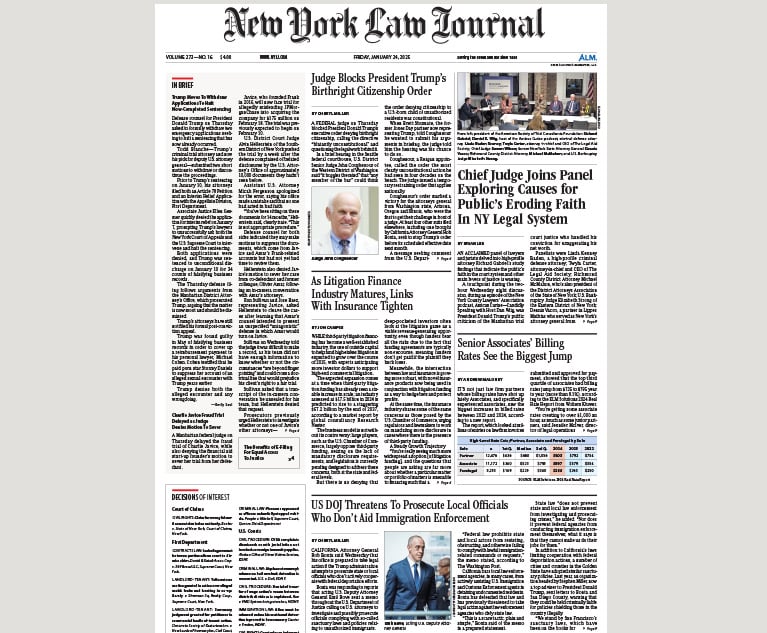'A Deal Is a Deal,' Except When It's Not
In his Divorce Law column, Alton L. Abramowitz looks at three recent cases as a reminder of what constitutes the applicable law, and a look at where the law may be going in the future.
August 09, 2018 at 02:45 PM
7 minute read
 Alton L. Abramowitz
Alton L. Abramowitz
Case law involving the interpretation, validity and enforcement of marital agreements of all types has pervaded the work of divorce lawyers and matrimonial judges for what seems like eons. There is a plethora of precedential decisions that have had an impact on the way family lawyers conduct their practices, and on the advice that they are called upon to give their clients in emotionally charged circumstances, where the wisdom of judges and the judgment of lawyers can impact the lives of litigants and their children for decades to come. Although past Divorce Law columns have addressed issues involving prenuptial, postnuptial, paternity, separation and other forms of marital agreements, from time to time it is important to step back and look at recent cases, both as a reminder of what constitutes the applicable law and a look at where the law may be going in the future. Hence, the focus of this column.
'Burns'
Appellate Division Justice Patrick H. NeMoyer, speaking for the Fourth Department, addressed a not uncommon conundrum in the recent case of Burns v. Burns, 2018 NY Slip Op 05411 (Fourth Dept. 7/25/2018). The facts involved conflicting understandings of a divorce settlement agreement that provided for spousal maintenance payments to continue to be paid until a date certain. To the ex-wife, this meant that she would receive those payments until that date regardless of her remarriage. On the other hand, the ex-husband believed that his obligation to support his ex-spouse should terminate upon her remarriage. The agreement was silent on the question. Instead, it contained a schedule of periodically decreasing support payments covering a 13-year term. Several months after the ex-wife's remarriage, the ex-husband notified her that he would stop paying maintenance as a result of that occurrence. The ex-wife moved for a money judgment for the unpaid maintenance amounts. Justice Richard A. Dollinger (one of the most prolific authors of matrimonial law decisions in New York State) denied the motion, and the ex-wife appealed.
The Appellate Division, noting the agreement's lack of a provision dealing with the ex-wife's remarriage, applied the “Dolman rule” which holds that in the absence of a contrary provision in a contract, it is presumed that the parties intended to apply the law of a particular statutory scheme as it existed at the time of the making of the contract. Dolman v. United States Trust Co. of N.Y., 2 NY2d 110, 116 (1956). The court then looked at Domestic Relations Law (DRL) §236B(1)(a), which defines “maintenance” and which also states that an award of maintenance “shall terminate upon the death of either party or upon the payee's valid or invalid marriage.”
Because the agreement was silent, the court applied the Dolman rule of contract construction, finding that the ex-wife's right to continued maintenance terminated on her remarriage. In doing so, the court cited numerous instances of reported cases where a divorce settlement agreement incorporated language that effectively rebutted the statutory presumption terminating maintenance in such circumstances, by specifically providing that maintenance payments would continue following the payee's remarriage. Further, the court noted that, unlike “virtually every divorce settlement agreement,” this agreement did not contain any language delineating any events where maintenance would be terminated, thereby inferring that the parties' intent was to follow the statutory scheme which provided for the termination of maintenance on remarriage.
The lesson of Burns, for drafters of matrimonial agreements, is that the parties' intent to vary from a clear and unequivocal statutory scheme must be specifically spelled out in those agreements, or the courts will impose that statutory scheme when called upon to interpret and enforce the terms and provisions of an agreement.
'Foley'
Foley v. Foley, 155 AD3d 1506 (Third Dept. 2017), provides another example of the need for the crafters of matrimonial agreements to be as specific as possible. In Foley, the parties signed a prenuptial agreement on the day preceding their wedding in 1987. The wife sued for divorce 27 years later in 2014. The agreement stated that it was intended to “fix and delineate certain of [the parties'] respective rights, claims and obligations.” Attached to the agreement as Exhibit A was a list that the parties “declared” to be the separate property of one or the other. In addition, the agreement specified that all property owned at the time of the marriage by a party would be his or her “separate property” in what the court found were “unequivocal” terms.
The husband argued that his pension and deferred compensation accounts, which he owned at the time of the marriage, were his separate property. However, both the Supreme Court and the Appellate Division held otherwise because Exhibit A, while listing broad specific categories of assets to be included within the agreement's definition of separate property (e.g., “cash accounts,” “securities,” “brokers margin accounts,” “loans to other and accounts receivable from others,” etc.), along with 15 parcels of real property did not include pensions or deferred compensation. Thus, by omitting reference to the pension or the deferred compensation, and by not including a broad category in which either would fit, the courts concluded that the parties did not intend that the pension and the deferred compensation were to be considered the husband's separate property.
Foley is another example of the need to specifically lay out the intent of the parties in an agreement when it is drafted. It, too, serves as a warning to drafters of matrimonial agreements and divorce documents to state in specific detail what it is that the parties intend to happen in the future.
'Koegel'
Finally, note should be taken of the Second Department's holding in Matter of Koegel,160 AD3d 11 (Second Dept. 2018), where the executor of the husband's estate petitioned to set aside the wife's notice of her election to take her spousal share of the estate based upon a prenuptial agreement executed in 1984, some 30 years prior to the husband's death. Although both parties' signatures were acknowledged before notaries, neither acknowledgment “attested to whether [either party] was known to the respective notaries.” The widow asserted that the prenuptial agreement was defective, invalid and unenforceable, citing Galetta v. Galetta, 21 NY3d 186 (2013), for the proposition that the acknowledgments should have included language “that the notaries knew the signers or had ascertained, through some sort of proof, that the signers were the persons described as required by DRL § 236B (3).”
Noting that the Galetta court had left open the question of whether a defective acknowledgment could be cured, the Appellate Division went into a careful analysis of what constitutes a proper acknowledgment based on the form laid out in Real Property Law §309-a(1). Despite the use of a defective form in Koegel, the court upheld the validity of the prenuptial agreement on the basis of sworn statements from the decedent's law partner and the attorney for the wife, who were the notaries on this prenuptial agreement, that they both recalled that the wife and the decedent acknowledged the prenuptial agreement while executing it in their presence, and that they actually knew the decedent and the wife at the time of the agreement's execution.
Thus, the drafting lesson to be learned from Koegel (where the agreement was enforced in accordance with the decedent's intentions), is that the scrivener of any kind of New York matrimonial agreement must be careful to use the proper form of acknowledgment in order to avoid future litigation over the validity of the agreement based on the language and the form of the acknowledgment chosen.
Alton L. Abramowitz is a partner at Mayerson Abramowitz & Kahn, which limits its practice to matrimonial and family law. He was national president of the American Academy of Matrimonial Lawyers (2013) and is a past chair of the New York State Bar Association's Family Law Section (2014–2015).
This content has been archived. It is available through our partners, LexisNexis® and Bloomberg Law.
To view this content, please continue to their sites.
Not a Lexis Subscriber?
Subscribe Now
Not a Bloomberg Law Subscriber?
Subscribe Now
NOT FOR REPRINT
© 2025 ALM Global, LLC, All Rights Reserved. Request academic re-use from www.copyright.com. All other uses, submit a request to [email protected]. For more information visit Asset & Logo Licensing.
You Might Like
View All
Paul Hastings, Recruiting From Davis Polk, Adds Capital Markets Attorney
3 minute read
Neighboring States Have Either Passed or Proposed Climate Superfund Laws—Is Pennsylvania Next?
7 minute readTrending Stories
Who Got The Work
J. Brugh Lower of Gibbons has entered an appearance for industrial equipment supplier Devco Corporation in a pending trademark infringement lawsuit. The suit, accusing the defendant of selling knock-off Graco products, was filed Dec. 18 in New Jersey District Court by Rivkin Radler on behalf of Graco Inc. and Graco Minnesota. The case, assigned to U.S. District Judge Zahid N. Quraishi, is 3:24-cv-11294, Graco Inc. et al v. Devco Corporation.
Who Got The Work
Rebecca Maller-Stein and Kent A. Yalowitz of Arnold & Porter Kaye Scholer have entered their appearances for Hanaco Venture Capital and its executives, Lior Prosor and David Frankel, in a pending securities lawsuit. The action, filed on Dec. 24 in New York Southern District Court by Zell, Aron & Co. on behalf of Goldeneye Advisors, accuses the defendants of negligently and fraudulently managing the plaintiff's $1 million investment. The case, assigned to U.S. District Judge Vernon S. Broderick, is 1:24-cv-09918, Goldeneye Advisors, LLC v. Hanaco Venture Capital, Ltd. et al.
Who Got The Work
Attorneys from A&O Shearman has stepped in as defense counsel for Toronto-Dominion Bank and other defendants in a pending securities class action. The suit, filed Dec. 11 in New York Southern District Court by Bleichmar Fonti & Auld, accuses the defendants of concealing the bank's 'pervasive' deficiencies in regards to its compliance with the Bank Secrecy Act and the quality of its anti-money laundering controls. The case, assigned to U.S. District Judge Arun Subramanian, is 1:24-cv-09445, Gonzalez v. The Toronto-Dominion Bank et al.
Who Got The Work
Crown Castle International, a Pennsylvania company providing shared communications infrastructure, has turned to Luke D. Wolf of Gordon Rees Scully Mansukhani to fend off a pending breach-of-contract lawsuit. The court action, filed Nov. 25 in Michigan Eastern District Court by Hooper Hathaway PC on behalf of The Town Residences LLC, accuses Crown Castle of failing to transfer approximately $30,000 in utility payments from T-Mobile in breach of a roof-top lease and assignment agreement. The case, assigned to U.S. District Judge Susan K. Declercq, is 2:24-cv-13131, The Town Residences LLC v. T-Mobile US, Inc. et al.
Who Got The Work
Wilfred P. Coronato and Daniel M. Schwartz of McCarter & English have stepped in as defense counsel to Electrolux Home Products Inc. in a pending product liability lawsuit. The court action, filed Nov. 26 in New York Eastern District Court by Poulos Lopiccolo PC and Nagel Rice LLP on behalf of David Stern, alleges that the defendant's refrigerators’ drawers and shelving repeatedly break and fall apart within months after purchase. The case, assigned to U.S. District Judge Joan M. Azrack, is 2:24-cv-08204, Stern v. Electrolux Home Products, Inc.
Featured Firms
Law Offices of Gary Martin Hays & Associates, P.C.
(470) 294-1674
Law Offices of Mark E. Salomone
(857) 444-6468
Smith & Hassler
(713) 739-1250








